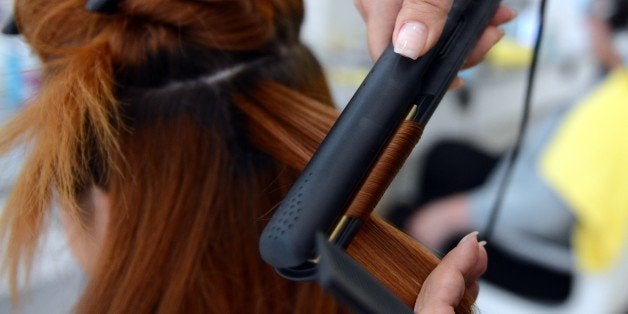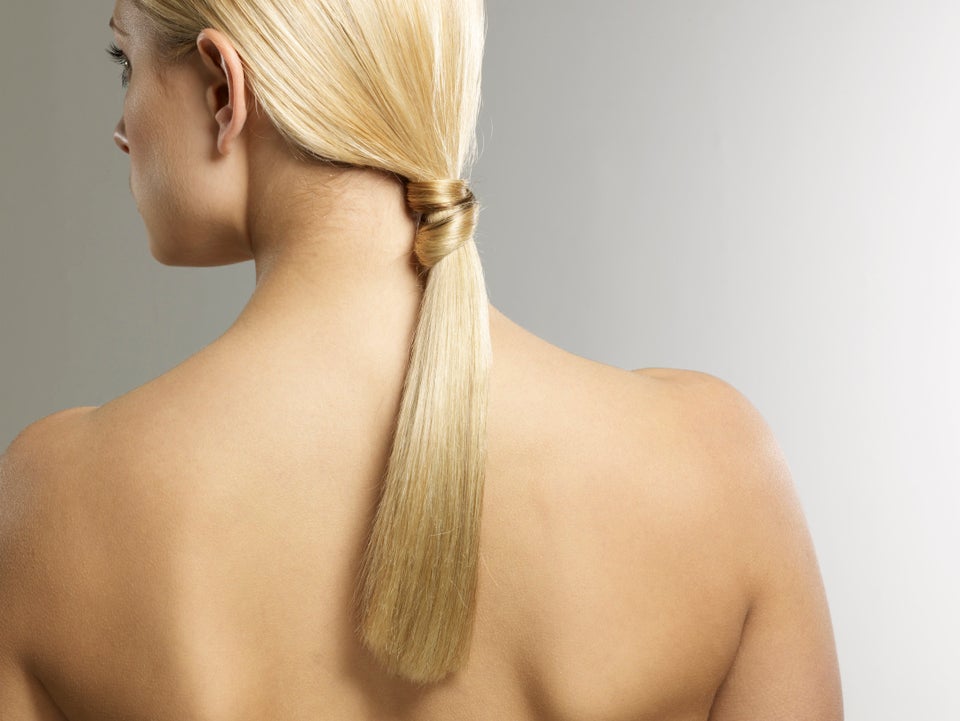
My days of sitting in the salon chair to get my thick curls flat-ironed until there's no kink or wave visible to the naked eye are long gone. Between the terrible smell of burnt hair and inevitable frizzy ends, having silky and straight strands momentarily just wasn't worth the long-term effects of damaged and brittle hair.
But I have yet to convince my closest friends and co-workers to step away from hair straightening tools ... for good.
To help explain what the flat iron is actually doing to your hair, I reached out to Dr. Jessica Krant, M.D., M.P.H., founder of Art of Dermatology in New York City, Elizabeth Cunnane Phillips, a trichologist at Philip Kingsley, and Paradi Mirmirani, M.D., board certified dermatologist in Vallejo, Calif., for the facts on this pressing (ha, get it?) matter.
Your hair can burn just like your skin -- you just can't feel it!
As someone with hair that sort of has a mind of its own, I get the allure of picking up the flat iron and showing your strands who's really boss. But the simple act of hair straightening "can wreak havoc on the condition of your hair if they are used too often or incorrectly," says Cunnane Phillips.
The hair shaft is a delicate structure with two main layers: the inner core and the outer coating. (It can also be divided into three separate layers: the cortex, cuticle and medulla.) Dr. Krant explains, "A healthy hair strand has a uniform structure with a hollow, water-and-air filled medulla and a smooth cuticle. This allows light to pass through it and gives it an internal glow (translucent center), and an external, reflective shine (smooth cuticle). Excessive heat damages both of these layers."
She adds, "The worst habits in hair styling are mainly about trying too hard to make the hair do things it doesn't want to do. Unfortunately, or fortunately if we kill it, the hair strands are dead once they come out of the scalp, so once damaged, it's not really possible to fully fix without cutting."
But before you do a big chop to rectify any damage, according to Dr. Mirmirani, "for the most part, the damage is to the hair fiber and not the hair follicle (root). So once you have new/virgin hair growth, it should be back to normal."
Heat-styling tools deplete your hair of its natural moisture.
"Moisture content is just as important to the health and beauty of your hair as it is to your skin," says Cunnane Phillips. "It’s what helps keep your strands nourished and elastic. Over-applying heat to your hair when it is already dried causes brittleness, breakage, dullness and dryness to the point where hair is stripped of its natural moisture causing your cuticles to dry and snap off."
The secret to safe hair straightening styling? Good timing and the proper use of tools and products.
Hair straighteners use the natural moisture content of your hair to create a new style. This is why Cunnane Phillips suggests that your hair be fairly dry for them to work properly. However, if care is not taken, they can make your hair brittle and extremely inelastic. "Steam-producing irons provide moisture, so are less likely to dry out your hair. The best of these are Teflon-coated irons," she says. And don't forget to prep your hair with a heat protectant to minimize heat-styling damage.
Burnt hair cells can build up on hot irons and cause them to stick to your hair, which can be very damaging. To avoid this hazard, replace your flat irons as needed. "You will know when to change it as 'stickiness' will occur and build-up on the ceramic plates will be evident," explains Cunnane Phillips.
The thinner and finer the hair shafts, the more easily they will be thrown into disarray by excessive heat.
But on the flip side, Dr. Krant says that people with thicker, curlier hair are using more heat to achieve their results which increases the risk of damage as well. She adds, "The actual damage that results is the same: dull, brittle hair with no shine, and, at worst, damage to scalp and hair follicles."
Color-treated hair is also less tolerant to excessive hair straightening, and as we age, Dr. Mirmirani adds that our locks' tolerance to heat also decreases "probably because the hair is finer and thinner."
While thicker, coarser hair can resist breakage better than fine or damaged hair, according to Cunnane Phillips, this creates a tempting desire to straighten and tame this hair type daily. "But be warned, this can quickly lead to mass breakage, which actually makes your hair appear more frizzy due to the different lengths of hair snapping off and sticking out. It can become quite a vicious cycle. Try to limit the use of straighteners to once or twice a week," she says.
Persistent heat and chemical damage to hair and scalp can eventually lead to permanent hair loss.
One of the biggest takeaways from Dr. Krant's advice is to never underestimate the damage you do, and to do your best to keep heat-styling devices and chemicals away from the scalp -- even if it might mean having slightly fuzzy roots.
"Scarring of the follicles [from excessive heat styling] can occur in a way that cannot be recovered through medications or procedures. There is also a delayed effect, so it can be months to years after the damage is done that the hair no longer grows well," she says.
Trying to heat style hair when it's wet will lead to steam damage, which is like boiling the hair from the outside.
Dr. Krant breaks down excessive heat styling in two parts:
"First, it literally boils the moisture in the center of the hair shaft, cracking the smooth walls of the medulla and creating bubbles within the shaft that break and disrupt the flow of light (imagine a cracked prism preventing a uniform rainbow from being created). Second, the cuticle, pushed outward irregularly by these bubbles, also cracks and splits, losing its smoothness and becoming rough and more like shingles, which disrupts the reflective sheen."
Wet hair is like a loose spring which stretches too easily and then breaks before the coil can snap back, so excessive tension can lead to more split ends and broken strands. So in trying to smooth your hair, Dr. Krant warns that you might accidentally end up with something worse.
This article has been updated with additional information about hair's physical composition.
